|

It is the most
innovative and promising Complete laser therapy device
released to date.
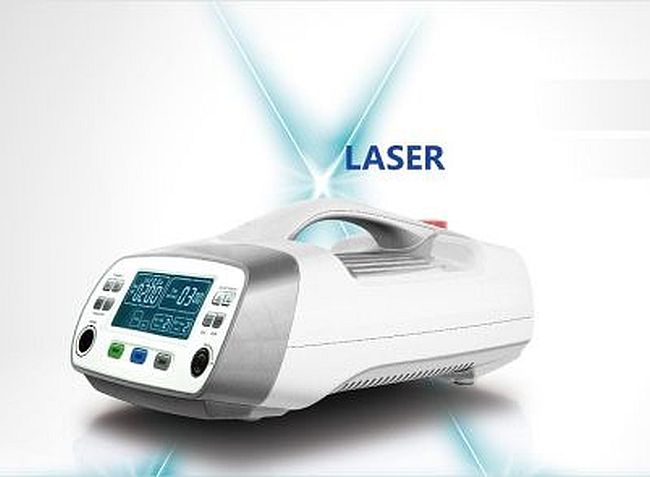
In 1967, a few years after the first working
laser was invented, Endre Mester in Semmelweis University,
Budapest, Hungary wanted to test if laser radiation might
cause cancer in mice [1]. He shaved the dorsal hair,
divided them into two groups and gave a laser treatment
with a low powered ruby laser (694 nm) to one group.
They did not get cancer, and to his surprise the hair
on the treated group grew back more quickly than the
untreated group. This was the first demonstration of "laser
biostimulation". Since then, medical treatment with
coherent-light sources (lasers) or non coherent light
(light-emitting diodes, LEDs) has passed through its
childhood and adolescence. Currently, low-level laser
(or light) therapy (LLLT), also known as "cold laser", "soft
laser", "biostimulation" or "photobiomodulation" is
practiced as part of physical therapy in many parts of
the world. In fact, light therapy is one of the oldest
therapeutic methods used by humans (historically as solar
therapy by Egyptians, later as UV therapy for which Nils
Finsen won the Nobel prize in 1904 [2]). The use of lasers
and LEDs as light sources was the next step in the technological
development of light therapy, which is now applied to
many thousands of people worldwide each day.
 |
LLLT mechanism and application. Incoming
red and NIR photons are absorbed in cell mitochondria,
producing reactive oxygen species (ROS) and releasing
nitric oxide (NO), which leads to gene transcription
via activation of transcription factors (NF-?B and
AP1).
Source |
Low-level
lasers are also called cold lasers, soft lasers,
biostimulation lasers, low-intensity lasers, etc...
Low-level laser therapy (LLLT) is the use of a low-powered
laser that emits specific wavelengths of light in the
visible red and/or far infrared range for therapeutic
purposes. This involves the application of low power
light to areas of the body in order to stimulate healing.
It is also known as cold laser, soft laser or low intensity
laser.
The reason why the technique is termed LOW-level is
that the optimum levels of energy density delivered are
low when compared to other forms of laser therapy as
practiced for ablation, cutting, and thermally coagulating
tissue. more

Controlled research into the
effects of low level laser is currently being conducted
in various European centres and in Japan.
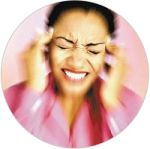 |
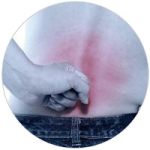 |
neuropathic pain |
dysfunction |
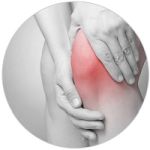 |
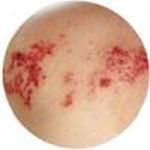 |
rheumatic |
infectious/
non-infectious
inflammation |
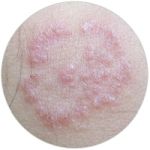 |
skin disease |
Knee injuries and conditions treated by low-level laser
include tendonitis, bursitis, meniscus tears, runners
knee/chondromalacia patella, knee joint effusion, iliotibial
band syndrome, osgood schlatters disease, osteoarthritis
and rheumatoid arthritis.
Low Level Laser Therapy for Osteoarthritis and
Rheumatoid Arthritis: A Metaanalysis
Lucie Brosseau, Vivian Welch, George Wells, Peter Tugwell, Robert
de Bie, Arne Gam, Katherine Harman, Beverly Shea, and Michelle Morin
Objective. Osteoarthritis (OA) and rheumatoid arthritis (RA) affect
a large proportion of the population. Low level laser therapy (LLLT)
was introduced as an alternative noninvasive treatment for RA and
OA about 10 years ago, but its effectiveness is still controversial.
We assessed the effectiveness of LLLT in the treatment of RA and
OA.
Results. In patients with RA, relative to a separate control group,
LLLT reduced pain by 70% relative to placebo and reduced morning
stiffness by 27.5 min (95% CI –52.0 to –2.9), and increased
tip to palm flexibility by 1.3 cm (95% CI –1.7 to –0.8).
Conclusion. LLLT should be considered for short term relief of
pain and morning stiffness in RA, particularly since it has few
side effects |
Low-level powers use very low power and
no heating of or damage to the tissue occurs. Low-level
laser treatment increases cell metabolism.
Karu has shown that visible and near-infrared
radiation is absorbed in the respiratory chain
molecules in the mitochondria (e.g., cytochrome
c oxidase), which results in increased metabolism,
which leads to signal transduction to other parts
of the cell, including cell membranes, and ultimately
to the photo response (e.g., stimulation of growth).
Karu T.I. (2003). Low-power laser
therapy. In: Biomedical Photonics Handbook
(T. VoDinh, ed.) CRC Press, Boca Raton, FL,
48, pp. 1-25 |
Low-level lasers emit light in the red
and infrared range. Red and infrared light penetrate
deeply into human tissue, where the light energy is absorbed
and turned into biochemical energy. By increasing cellular
energy in the treated area, low-level laser therapy is
believed to speed healing and reduce inflammation and
pain. There are no reported side effects
|
Immunoregulation
Direct irradiating of the lesion
area where blood flow is decreased and indirect irradiating
the
sympathetic ganglia dominating this lesion area can
increase blood flow to provide adequate blood supply
and nutrition, promote metabolite exclusion. eg penile
tissue |
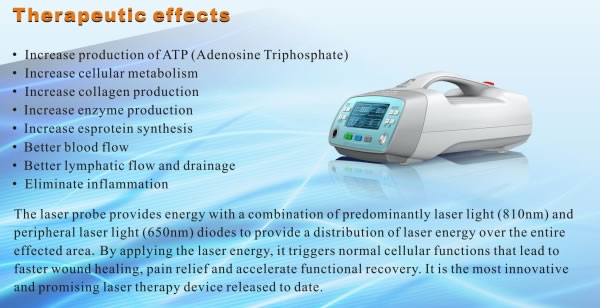
lasers
are not magical; it is the light that they produce
that yields the biological effect
Low-level laser therapy may sometimes provide
an effective alternative to surgery or medications—without
accompanying side effects. It can help regenerate tissue,
reduce inflammation, decrease pain, and increase immunity,
and research has shown its efficacy in treating many conditions,
including:
 Plantar fasciitis Plantar fasciitis
 Rheumatoid arthritis Rheumatoid arthritis
 Temporomandibular joint disorder Temporomandibular joint disorder
 Exercise-induced muscle fatigue and injury prevention Exercise-induced muscle fatigue and injury prevention
 Skin conditions Skin conditions
 Traumatic brain injury Traumatic brain injury
 Stroke Stroke
 Reduction of inflammation: It can occur within hours
to days. Reduction of inflammation: It can occur within hours
to days.
 Low dose laser therapy for hair loss Low dose laser therapy for hair loss
 "Low level laser therapy is a safe form of
light/heat treatment under investigation for a variety
of health indications. It is being used to treat the genetic
forms of hair loss common in men and women, androgenetic
alopecia or pattern balding. " Source "Low level laser therapy is a safe form of
light/heat treatment under investigation for a variety
of health indications. It is being used to treat the genetic
forms of hair loss common in men and women, androgenetic
alopecia or pattern balding. " Source
 Increase
production of ATP (Adenosine Triphosphate) Increase
production of ATP (Adenosine Triphosphate)
 Increase cellular metabolism Increase cellular metabolism
 Increase collagen production Increase collagen production
 Increase enzyme production Increase enzyme production
 Increase esprotein synthesis Increase esprotein synthesis
 Better blood flow Better blood flow
 Better lymphatic flow and drainage Better lymphatic flow and drainage
 Eliminate inflammation Eliminate inflammation
In 2007, low-level
light therapy (LLLT) was approved by the FDA
as a treatment
for hair loss.
[23]
LLLT is
also known as low level laser therapy, red light
therapy, cold laser, soft laser, biostimulation,
and photobiomodulation.[24–26]
Most experts agree that LLLT is safe for the treatment
of hair loss, but more studies are needed to confirm
its therapeutic effects.[24] LLLT was discovered
in the 1960s and first used by the National Aeronautics
and Space Administration (NASA) to accelerate wound
healing in space.[25] Since then, LLLT has been used
to reduce neurogenic pain, reduce inflammation, and
promote wound healing.[25–27] Other uses include
nonmelanoma skin cancer and its precursors, acne
vulgaris, photorejuvenation, hidradenitis suppurativa,
and psoriasis.[28]
It may also prove helpful in killing bacteria, fungi,
and viruses.[28] LLLT has also been used to achieve
attenuation of retinal toxicity in methanol-poisoned
rats.[27] The role of LLLT in hair growth was discovered
accidentally in 1967.[26] In an attempt to test if
LLLT causes cancer in shaved mice, researchers discovered
that these mice did not develop cancer, but instead
grew hair.[26] Source |
How does it work?
"A laser is a device that emits light through
a process of optical amplification based on the stimulated
emission of photons. The term “laser” originated
as an acronym for light amplification by stimulated emission
of radiation. The emitted laser light is notable for
its high degree of spatial and temporal coherence."
| "LLLT involves exposing cells or tissue to low
levels of red and near infrared (NIR) light, and
is referred
to as “low level” because of its use of
light at energy densities that are low compared to
other forms of laser therapy that are used for ablation,
cutting, and thermally coagulating tissue. LLLT is
also known as “cold laser” therapy as the
power densities used are lower than those needed to
produce heating of tissue. " |
Photons, which are particles of electromagnetic energy,
are emitted from the low power laser. These particles
enter the tissues and are absorbed in the mitochondria,
which are tiny structures within the substance of each
individual cell. The energy is converted to chemical
energy within the cell. The permeability of the cell
membrane changes which in turn produces various physiological
effects. These physiological changes affect a variety
of cell types including macrophages, fibroblasts, endothelial
cells and mast cells.
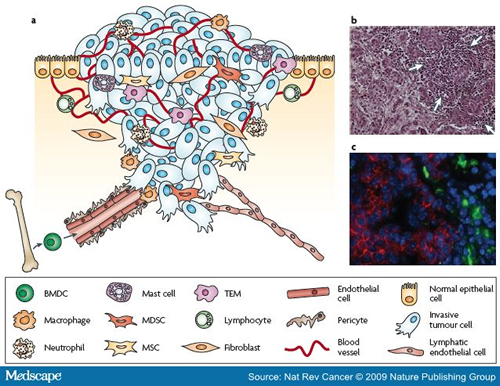
Low-level laser therapy
(LLLT)/ Photobiological
techniques are sometimes less invasive than those used
in other areas of science, allowing the sample to respond
without incurring much damage. It is no coincidence that
two of the most important macromolecules in biology -
DNA and chlorophyll - respond readily to light. In fact
absorption of light by plants is the driving force for
much of the life on earth.
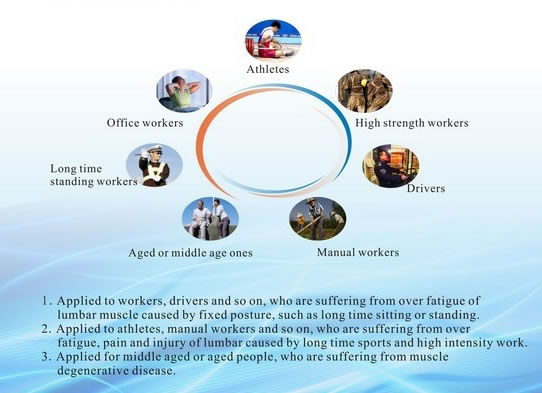
Cold Laser
Therapy is a treatment
whereby a cold laser is utilized to treat chronic and
acute pain. Cold laser therapy is used for persons
suffering from back and neck pain, musculoskeletal
pain, joint pain associated with arthritis, fibromyalgia,
tendonitis, busiitis, neuropathy, Achilles tendon pain,
migraine headaches, sprains and strains, carpal tunnel
and other associated pains. Cold laser therapy is also
used in the treatment of conditions such as TMJ, reflex
sympathetic dystrophy (RSD) and other inflammatory
and scarring conditions
|
Strong analgesia
After irradiation, this device can accelerate the
release of the morphine-like substance in the pain
area and reduces conduction velocity, strength and
impulse frequency of the nervous system of the irradiated
portion to achieve a strong analgesic effect. |
What is it used for?
Low-power laser therapy is used by physical therapists
to treat a wide variety of acute and chronic musculoskeletal
aches and pains, by dentists to treat inflamed oral tissues
and to heal diverse ulcerations, by dermatologists to
treat edema, non-healing ulcers, burns, and dermatitis,
by orthopedists to relieve pain and treat chronic inflammations
and autoimmune diseases, and by other specialists, as
well as general practitioners. Laser therapy is also
widely used in veterinary medicine (especially in racehorse-training
centers), and in sports-medicine and rehabilitation clinics
(to reduce swelling and hematoma, relieve pain, improve
mobility, and treat acute soft-tissue injuries). Lasers
and LEDs are applied directly to the respective areas
(e.g., wounds, sites of injuries) or to various points
on the body (acupuncture points, muscle-trigger points).
|
Rapid anti-inflammatory
Irradiating the lesion area can increase the activity
of phagocytic cells and enhance immunity to achieve
rapid anti-inflammatory effect. |
Cold Laser therapy, whether using low intensity radiation
in the visible or near-infrared region can be beneficial
in a number of clinical situations, from pain remission
to wound healing. Unfortunately, the absence of this
type of phototherapy from the mainstream of medicine
makes it unavailable to patients who could benefit from
it.
 Soft
tissue injuries, including sprains and strains, tendonitis
and haematomas Soft
tissue injuries, including sprains and strains, tendonitis
and haematomas
 Joint
conditions, including arthritis, tenosynovitis
and capsulitis Joint
conditions, including arthritis, tenosynovitis
and capsulitis
 Chronic
pain, including Trigeminal neuralgia and
chronic neck and back pain Chronic
pain, including Trigeminal neuralgia and
chronic neck and back pain
 Wound
management, including skin ulcers, pressure
sores and burns Wound
management, including skin ulcers, pressure
sores and burns
 Skin
infections, including cold sores, warts,
verruca Skin
infections, including cold sores, warts,
verruca
 The
laser may also be focussed on acupuncture
points to assist with smoking cessation and
the relief of short or long-term pain The
laser may also be focussed on acupuncture
points to assist with smoking cessation and
the relief of short or long-term pain
 |
LLLT
for central nervous system (CNS)
neurological disorders. NIR light can penetrate through
the skull into the brain, reducing neuronal cell
death, reducing inflammation and increasing the likelihood
of neurogenesis. The retinal nerves and the spinal
cord are classified as part of the CNS, and light
is delivered for similar reasons into the eye or
to the neck or back at the site of the spinal cord
lesion. Source |
 LLLT
for pain relief, inflammation and healing. In recent
years, there has been growing interest in the use of
laser biostimulation as a therapeutic modality for pain
management (Strong, 2002). Alterations in neuronal activity
have been suggested to play a role in pain relief by
laser therapy. LLLT
for pain relief, inflammation and healing. In recent
years, there has been growing interest in the use of
laser biostimulation as a therapeutic modality for pain
management (Strong, 2002). Alterations in neuronal activity
have been suggested to play a role in pain relief by
laser therapy.
 Many
published reports document the positive findings for
laser biostimulation in pain management. This level of
evidence relates to chronic neck pain (Chow et al., 2005),
tendonitis (Bjordal et al., 2006), chronic joint disorders
(Bjordal et al., 2003), musculoskeletal pain (Gerber
et al., 2001), and chronic pain (Aronoff, 1999). Randomised
controlled trials provide evidence for the efficacy of
laser therapy in chronic low back pain (Frazer et al.,
2003). Many
published reports document the positive findings for
laser biostimulation in pain management. This level of
evidence relates to chronic neck pain (Chow et al., 2005),
tendonitis (Bjordal et al., 2006), chronic joint disorders
(Bjordal et al., 2003), musculoskeletal pain (Gerber
et al., 2001), and chronic pain (Aronoff, 1999). Randomised
controlled trials provide evidence for the efficacy of
laser therapy in chronic low back pain (Frazer et al.,
2003).
 LLLT
significantly improves wound healing in both diabetic
rats and diabetic mice. LLLT was also effective in X-radiation
impaired wound healing in mice. Furthermore, the total
collagen content was significantly increased at 2 months,
when compared with control wounds. The beneficial effect
of LLLT on wound healing can be explained by considering
several basic biological mechanisms, including the induction
of the expression of cytokinesis and growth factors known
to be responsible for the many phases of wound healing.
Figure below shows the mechanism of LLLT on wound healing
(Lucas et al., 2002). LLLT
significantly improves wound healing in both diabetic
rats and diabetic mice. LLLT was also effective in X-radiation
impaired wound healing in mice. Furthermore, the total
collagen content was significantly increased at 2 months,
when compared with control wounds. The beneficial effect
of LLLT on wound healing can be explained by considering
several basic biological mechanisms, including the induction
of the expression of cytokinesis and growth factors known
to be responsible for the many phases of wound healing.
Figure below shows the mechanism of LLLT on wound healing
(Lucas et al., 2002).
 |
LLLT for Wound
Healing. Cells in
the wound respond to light induced reactive oxygen
species (ROS) leading to the expression of growth
factors, such as transforming growth factor beta
(TGF), and platelet derived growth factor (PDGF),
which encourage synthesis of more collagen, increased
formation of blood vessels, and less inflammation,
all of which increase wound healing. Source |
Most health care plans do not cover LLLT
because the FDA considers LLLT investigational, experimental
and unproven (though approved for use since 2002 by the
FDA). More large clinical trials that follow stringent
scientific guidelines are needed. Though there have been
many trials they have been considered inadequate. (1)
The cost of one treatment
is typically about $80-100 with an average of 10
treatments given. The
number of LLLT treatments needed depends upon the
condition being treated, the severity of the condition
and individual response. The effect of low-level
laser therapy is accumulative. Though some people
have immediate results, improvements are often
noticed until after 3-5 treatments.
Now you can own your own
system for the approximate cost of treatments |
|
Tissue repair
Irradiation can accelerate synthesis of DNA and
RNA, boost the growth of new blood vessels and granulation
tissue, accelerate protein synthesis, accelerate
the metabolism and maturation of a variety of tissue
repair cells and boost the generation, deposition
and crosslinking of collagenous fibers to achieve
tissue repair. |
Cold laser therapy increases serotonin
levels which allow the body to heal itself. Cold laser
therapy is non-thermal and noninvasive. A combination
of cold laser and electric stimulation, cold laser therapy
is one of the most effective healing therapies in the
medical community today. Completed in one to three sessions,
cold laser therapy is not only significant in reducing
treatment times, it is cost effective as well.
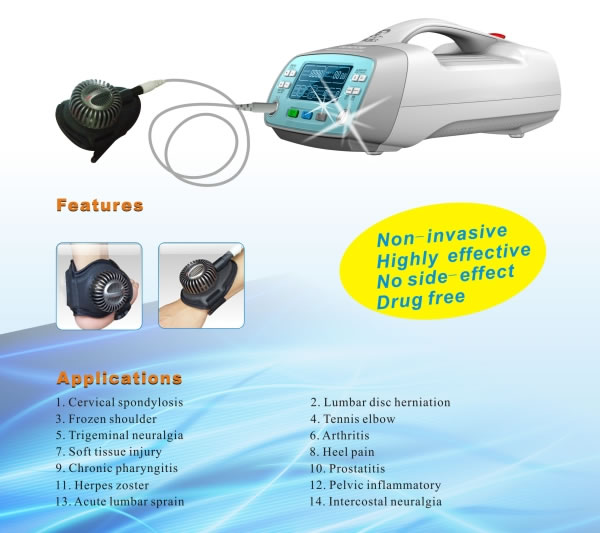

Therapeutic Principle:
"Our Semiconductor Laser Therapeutic Instrument
has been developed based on modern laser medicine and
clinical practice. It adopts low-level laser with the
wavelength of 650nm, through specific parts of irradiation
and using light radiation of laser and wavelength relation
to change the biological characteristics and peel off
the fat layer and cholesterol in the red blood cells,
to improve the activity and oxygen carrying capacity
as well as the deformability of cells, reduce the concentration
of middle molecules in the blood, improve hem rheological
properties and lower triglycerides and cholesterol, in
order to effectively treat and prevent diseases.

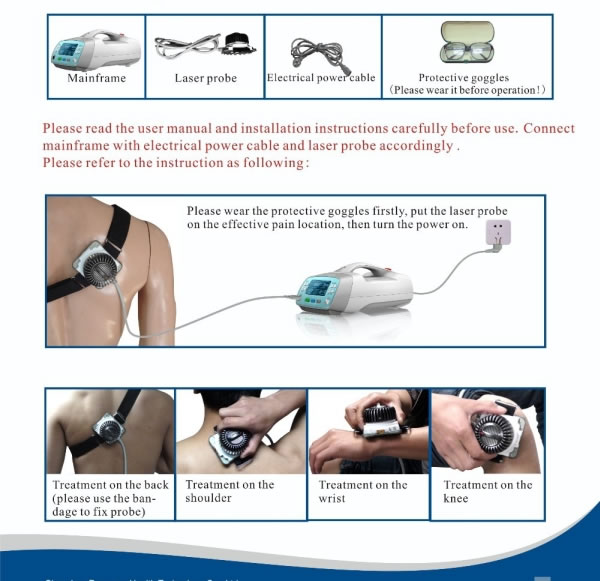
Low level laser therapy (Photobiomodulation
therapy) for breast cancer-related lymphedema: a systematic
review
Breast cancer related lymphedema (BCRL)
is a prevalent complication secondary to cancer treatments
which significantly impacts the physical and psychological
health of breast cancer survivors. Previous research shows
increasing use of low level laser therapy (LLLT), now commonly
referred to as photobiomodulation (PBM) therapy, for BCRL.
This systematic review evaluated the effectiveness of LLLT
(PBM) in the management of BCRL. Source
Low-level laser therapy: a standard of supportive
care for cancer therapy-induced oral mucositis in head
and neck cancer patients?
Oral mucositis (OM) is still a common and
severe acute side-effect of many oncologic treatments,
especially in patients treated for head and neck cancer.
It may affect quality of life, require supportive care
and impact treatment planning and its efficacy. Low-level
laser therapy (LLLT) seems to promote pain relief and reduces
OM incidence and its severity. It has been recommended
for these patients as a treatment option but without any
consensus in the LLLT procedure. New recommendations and
perspectives for clinical trials will be discussed. Source
Low-level
laser therapy for chemotherapy-induced peripheral neuropathy. Source

All in one units
Caution:
1) Not suitable for the following groups:
cancer patient, pregnancy, patient with hemorrhagic diseases.
2) Children shall only use the instrument under the direction
of their parents.3) The elder patients and sensitive patients
must accept the low-power and short-time treatment at the
beginning, the rate of work could be increased as the body
adjusts.
LLLT Irradiation should be avoided over melanomas
as the irradiance may increases "melanoma tumor "growth
in vivo.
Never
receive LLLT over your thyroid—LLLT can compromise
thyroid function.
Eyes:
Do not aim laser beams into the eyes and everyone present
should wear appropriate safety spectacles.


Knee
Care Laser combines massage, pressure
kneading, vibration and Laser irradiation and
LED technologies together. It can improve
the blood circulation as well as enhance the
strength and stability of the Knee
Specifications
 Model
Number: RG-XGB Model
Number: RG-XGB
 Media
Semiconductor laser(640-655nm,mW max & Light
Emission Diode Media
Semiconductor laser(640-655nm,mW max & Light
Emission Diode  Weight
: 400g Weight
: 400g
 Environmental
Temperature: 5C-40C Environmental
Temperature: 5C-40C
 Relative
Humidity:<80% Relative
Humidity:<80%
 Power
Supply: DC 6.0V,2A(Power Adaptor) Power
Supply: DC 6.0V,2A(Power Adaptor)
Manual
|
| |
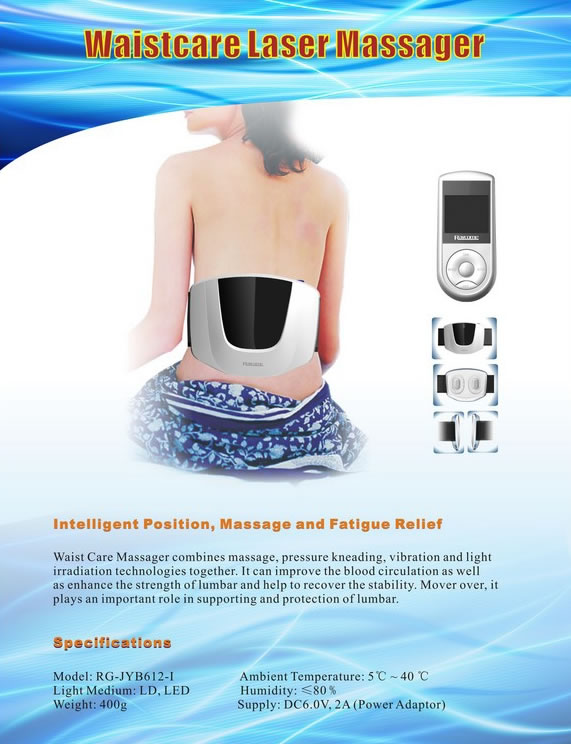
Waist
Care Laser
Waist Care Massager combines
massage, pressure kneading, vibration and Laser
irradiation and LED technologies together.
It can improve the blood circulation as well as
enhance the strength and stability of the lumbar
region. It plays an important role in supporting
and protecting the Lower back as well
Specifications
 Model
Number : RG-JY Model
Number : RG-JY
 Media
Semiconductor laser(640-655nm,mW max & Light
Emission Diode Media
Semiconductor laser(640-655nm,mW max & Light
Emission Diode
 Environmental
Temperature:5c-40c Environmental
Temperature:5c-40c
 .
Relative Humidity: No more than 80% 5. Power Supply:
DC6.0V,2A(Power Adaptor) .
Relative Humidity: No more than 80% 5. Power Supply:
DC6.0V,2A(Power Adaptor)
 Weight: 400g Weight: 400g
Manual
|
| |
|

